 I’m kicking off my 2020 Resolution fresh out the gate, starting with a rewatch and review of the science fantasy series Voltron: Legendary Defender, created by DreamWorks Animation, animated by Studio Mir, and currently available for streaming on Netflix as well as DVD.
I’m kicking off my 2020 Resolution fresh out the gate, starting with a rewatch and review of the science fantasy series Voltron: Legendary Defender, created by DreamWorks Animation, animated by Studio Mir, and currently available for streaming on Netflix as well as DVD.
Voltron: Legendary Defender is a reimagining and update of the 1984 series Voltron, which is in and of itself a fully dubbed, recut, and replotted version of Saburō Yatsude and Toei Animation’s Beast King GoLion (百獣王ゴライオン). With nods to both Beast King GoLion and the series that evolved into 1984’s Voltron, VLD is brought to you by the same creative talents that engineered the critically acclaimed Avatar: The Last Airbender and its follow-up The Legend of Korra, as well as Netflix’s current masterpiece, The Dragon Prince (which I’ll be reviewing as the second part of my Resolution Project).
I didn’t grow up with Voltron. In fact, mecha anime was not my thing for a long time, and still a genre I’m kind of meh about (with exceptions being Tengen Toppa Gurren Lagann and Evangelion). The whole reason I got into Voltron: Legendary Defender in the first place was because of the creative team behind it, and also the immeasurable fanart and doujinshi that dotted my social media. Otherwise, this would’ve remained off my radar and I wouldn’t have given this a try. So I did…and I loved it.
There’s a reason this show is referred to as an “essential animated series” with a critical consensus that it “honors its source material with beautifully expressive animation and impactful action.” In this revisit, I hope to show you all why. Let’s deep-dive into season one!
The Premise:
DreamWorks’ Voltron Legendary Defender reimagines one of the most popular fan-favorite shows of all time in this all-new, comedic, action-packed series. Five unsuspecting teenagers, transported from Earth into the middle of a sprawling intergalactic war, become pilots for five robotic lions in the battle to protect the universe from evil. Only through the true power of teamwork can they unite to form the mighty warrior known as Voltron, who was first formed 10,000 years ago.
Discussion: Just to keep things easy, I’m going to break my review into categories and use these for every season review. Enjoy!
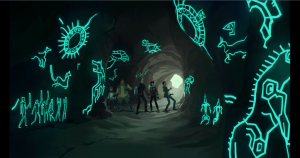 Story: As far as delivering the story goes, Voltron: Legendary Defender is a master of pacing and balance. The overarching task for this season is to establish what Voltron is, why it has to defend the universe, and how that’s relevant to our heroes (not-so-spoiler alert: Earth is not off-limits when it comes to the Galra Empire and its thirst to destroy worlds). While each episode has its own problem the characters need to work through, there are also larger issues at stake that are threaded to each other and further expanded from episode to episode, ensuring that there are no fillers and that everything is relevant and related. My favorite story thread involves the exploration of the history of the Galra and the Alteans and how that contributes to the present conflict and pursuit of Voltron. Additionally, while this show is marketed to children, it’s unafraid to go into darker and deeper territory. The good news is that this is balanced with humor (which is hard to pull off! There’s no tonal whiplash here!) and great characterization.
Story: As far as delivering the story goes, Voltron: Legendary Defender is a master of pacing and balance. The overarching task for this season is to establish what Voltron is, why it has to defend the universe, and how that’s relevant to our heroes (not-so-spoiler alert: Earth is not off-limits when it comes to the Galra Empire and its thirst to destroy worlds). While each episode has its own problem the characters need to work through, there are also larger issues at stake that are threaded to each other and further expanded from episode to episode, ensuring that there are no fillers and that everything is relevant and related. My favorite story thread involves the exploration of the history of the Galra and the Alteans and how that contributes to the present conflict and pursuit of Voltron. Additionally, while this show is marketed to children, it’s unafraid to go into darker and deeper territory. The good news is that this is balanced with humor (which is hard to pull off! There’s no tonal whiplash here!) and great characterization.
 Characters: This doesn’t happen often, but I like every one of our protagonists. This means all the pilots of Voltron: Shiro (Josh Keaton), Lance (Jeremy Shada), Keith (Steven Yeun), Pidge (Bex Taylor-Klaus), and Hunk (Tyler Labine) — and the rest of the team, Princess Allura (Kimberly Brooks) and Coran (Rhys Darby). They are well-developed, and I think what delivers their characterization so well is their dialogue and the incredible voice acting (some of the best I’ve heard). Everyone emotes differently. Everyone has their own syntax, slang, and style. While everyone is part of Team Voltron, their personalities are unique enough that you can’t mistake them. My personal favorites are Shiro, the voice of reason (“Patience is focus” is one of the credos he passes on to his team) and the glue that keeps everyone together; Pidge, who is enthusiastic and driven and geeky; and Keith, only because I have a thing for the sometimes broody, impulsive, guys. And long hair.
Characters: This doesn’t happen often, but I like every one of our protagonists. This means all the pilots of Voltron: Shiro (Josh Keaton), Lance (Jeremy Shada), Keith (Steven Yeun), Pidge (Bex Taylor-Klaus), and Hunk (Tyler Labine) — and the rest of the team, Princess Allura (Kimberly Brooks) and Coran (Rhys Darby). They are well-developed, and I think what delivers their characterization so well is their dialogue and the incredible voice acting (some of the best I’ve heard). Everyone emotes differently. Everyone has their own syntax, slang, and style. While everyone is part of Team Voltron, their personalities are unique enough that you can’t mistake them. My personal favorites are Shiro, the voice of reason (“Patience is focus” is one of the credos he passes on to his team) and the glue that keeps everyone together; Pidge, who is enthusiastic and driven and geeky; and Keith, only because I have a thing for the sometimes broody, impulsive, guys. And long hair.

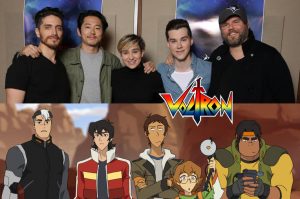 Voice Acting: I mentioned above, but I think this is one of the most talented casts assembled for a series. Everyone sounds expressive and authentic to their character, and while there are moments of comedy or emotion that are cartoony (this is a cartoon, after all), I liked not only the sound of everyone’s voice but the way they used it to define their characters. Particular standouts this season include Pidge, Hunk, and Princess Allura…but again, everybody seems perfectly cast and very talented. One of my favorite moments in voice acting is in the 2nd episode where Team Voltron is practicing with the Lions…I’m just going to call this the “Yaaaay!” sequence. It’s a lot of fun.
Voice Acting: I mentioned above, but I think this is one of the most talented casts assembled for a series. Everyone sounds expressive and authentic to their character, and while there are moments of comedy or emotion that are cartoony (this is a cartoon, after all), I liked not only the sound of everyone’s voice but the way they used it to define their characters. Particular standouts this season include Pidge, Hunk, and Princess Allura…but again, everybody seems perfectly cast and very talented. One of my favorite moments in voice acting is in the 2nd episode where Team Voltron is practicing with the Lions…I’m just going to call this the “Yaaaay!” sequence. It’s a lot of fun.
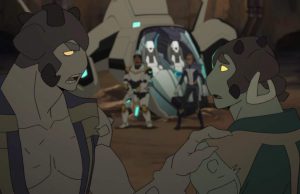 Low Points of the Season: I am not a fan of how the Balmerans speak because it’s a bit unnatural and cringey. The Balmerans have been forced into servitude by the Galra and have spent most of their lives underground harvesting Balmeran crystals, which provide the energy needed to power massive space ships. While some Balmerans have to work on the surface, most of them are stuck below — when Hulk meets Shay, one of the things she asks him is “What is the sky like?” What I’m getting at is the Balmerans don’t get out much. I can’t speak to the richness of their culture or education, but somehow they managed to craft their vocabulary using awkward pseudo-Shakespearean English and I’m like, “how did they get exposed to that?” It reminds me of what writers do when they don’t want characters to sound modern: remove all contractions and rearrange the order of words (like in M. Night Shyamalan’s The Village). That’s not so bad by itself, but when a character (Rax, for example), sounds almost modern and then tosses in an “Exuent!” or “Vex!” it feels awkward and out of place. I know they can’t go full old-school because, reminder, this show is marketed to children! And I also understand that in a world with multiple planets and cultures and creatures, people won’t sound the same, but this was so random.
Low Points of the Season: I am not a fan of how the Balmerans speak because it’s a bit unnatural and cringey. The Balmerans have been forced into servitude by the Galra and have spent most of their lives underground harvesting Balmeran crystals, which provide the energy needed to power massive space ships. While some Balmerans have to work on the surface, most of them are stuck below — when Hulk meets Shay, one of the things she asks him is “What is the sky like?” What I’m getting at is the Balmerans don’t get out much. I can’t speak to the richness of their culture or education, but somehow they managed to craft their vocabulary using awkward pseudo-Shakespearean English and I’m like, “how did they get exposed to that?” It reminds me of what writers do when they don’t want characters to sound modern: remove all contractions and rearrange the order of words (like in M. Night Shyamalan’s The Village). That’s not so bad by itself, but when a character (Rax, for example), sounds almost modern and then tosses in an “Exuent!” or “Vex!” it feels awkward and out of place. I know they can’t go full old-school because, reminder, this show is marketed to children! And I also understand that in a world with multiple planets and cultures and creatures, people won’t sound the same, but this was so random.
Also, this is only something I can only claim as a complaint from hindsight (if you are a first-time watcher, you’re not going to catch this, so spoiler alert): Princess Allura explains that Alteans are a chameleon-like race, and when she and Shiro plan to sneak onto a Galra ship, Allura stretches her body and purples her skin, and voilà! She can totally pass for Galra. This is a super-impressive ability that I’m sure would be helpful in future scrapes but as far as I can recall, we never see this again in any season. I consider this a continuity issue and I’m not a fan of those.
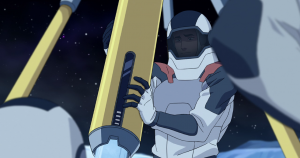 High Points of the Season: I loved all of the episodes this season, but I’m choosing the opener as one of its most brilliant. It is difficult to nail the first episode and in my experience, most shows don’t really seem to get started until the third. This first episode, “The Rise of Voltron,” has much to be admired for. Granted, this episode clocks in at an hour since it’s the special series premiere and has a lot of work to do. We jump from the Kerberos prologue which establishes Shiro as the major lead and future head of Voltron (the Black Lion); it also sets up the mystery about his character that gets gradually explored over multiple episodes and seasons, and lastly, creates the major motivation and plot for Pidge’s character (the Green Lion), which also is explored over episodes and seasons. It introduces the Galra, which are officially the first alien people to make contact with humans, and establish them as the Big Bad of the series. We get all this from the first few minutes of prologue (!) and then it expands from there throughout the episode.
High Points of the Season: I loved all of the episodes this season, but I’m choosing the opener as one of its most brilliant. It is difficult to nail the first episode and in my experience, most shows don’t really seem to get started until the third. This first episode, “The Rise of Voltron,” has much to be admired for. Granted, this episode clocks in at an hour since it’s the special series premiere and has a lot of work to do. We jump from the Kerberos prologue which establishes Shiro as the major lead and future head of Voltron (the Black Lion); it also sets up the mystery about his character that gets gradually explored over multiple episodes and seasons, and lastly, creates the major motivation and plot for Pidge’s character (the Green Lion), which also is explored over episodes and seasons. It introduces the Galra, which are officially the first alien people to make contact with humans, and establish them as the Big Bad of the series. We get all this from the first few minutes of prologue (!) and then it expands from there throughout the episode.
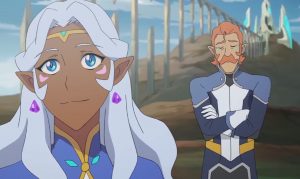 Our remaining members of Voltron are introduced through the Galaxy Garrision — Lance (the Blue Lion), Hunk (the Yellow Lion), and Keith, (the Red Lion). Then we get the next members of Team Voltron — the Alteans, Princess Allura and Coran, and lastly meet the major villains, the druid witch Haggar and Emperor Zarkon, and their commander Sendak. We learn quickly and easily that Voltron isn’t just technology but magic, and psychically linked to each Paladin (the name for the members of Voltron, who are essentially knights). The Lions even match the main components of each Paladin’s personality, so while they are sentient to a certain degree, they can’t operate on their own without partnering with a pilot that’s essentially an extension of who they are. We get so much information that’s essential to understanding the world of Voltron and its characters, and I admire how they conveyed it in this premiere.
Our remaining members of Voltron are introduced through the Galaxy Garrision — Lance (the Blue Lion), Hunk (the Yellow Lion), and Keith, (the Red Lion). Then we get the next members of Team Voltron — the Alteans, Princess Allura and Coran, and lastly meet the major villains, the druid witch Haggar and Emperor Zarkon, and their commander Sendak. We learn quickly and easily that Voltron isn’t just technology but magic, and psychically linked to each Paladin (the name for the members of Voltron, who are essentially knights). The Lions even match the main components of each Paladin’s personality, so while they are sentient to a certain degree, they can’t operate on their own without partnering with a pilot that’s essentially an extension of who they are. We get so much information that’s essential to understanding the world of Voltron and its characters, and I admire how they conveyed it in this premiere.
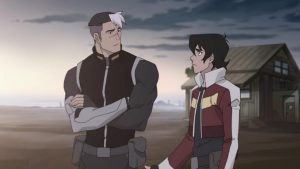 Final Thoughts: There’s a lot going for Voltron: Legendary Defender in this first season: excellent animation, solid music, a complex storyline, top-notch acting, and memorable characters. The plot is memorable because for every success Team Voltron makes, there are serious pitfalls and threats that knock them two steps back, which makes for a busy plot and great conflict. The mysteries behind what happened to Shiro when he was captured on Kerberos (and he very clearly has PTSD) draws you in and makes you root for him; the tragedy of the Alteans and the gravity of an Empire that destroys worlds in pursuit of a magical energy is also a mystery worth exploring. The dynamic between the Paladins — especially the playful rivalry between Lance and Keith and Shiro and Keith’s deep bond– is also memorable. The season closer is also a great character moment for Shiro (the episode is called “The Black Paladin” for a reason) that reveals more about him and his personal code. He’s a tough, great character and worthy of leading the Paladins of Voltron.
Final Thoughts: There’s a lot going for Voltron: Legendary Defender in this first season: excellent animation, solid music, a complex storyline, top-notch acting, and memorable characters. The plot is memorable because for every success Team Voltron makes, there are serious pitfalls and threats that knock them two steps back, which makes for a busy plot and great conflict. The mysteries behind what happened to Shiro when he was captured on Kerberos (and he very clearly has PTSD) draws you in and makes you root for him; the tragedy of the Alteans and the gravity of an Empire that destroys worlds in pursuit of a magical energy is also a mystery worth exploring. The dynamic between the Paladins — especially the playful rivalry between Lance and Keith and Shiro and Keith’s deep bond– is also memorable. The season closer is also a great character moment for Shiro (the episode is called “The Black Paladin” for a reason) that reveals more about him and his personal code. He’s a tough, great character and worthy of leading the Paladins of Voltron.
We’ve spent the entire season (11 episodes) building Team Voltron from the ground up. An assemblage of very unique individuals, often in conflict each other, is brought together to save the universe, and it’s all dependent on whether or not they can come together as a team. They don’t gel from the beginning. They continue to compete with each other and clash from time to time, but throughout the season they learn to depend on each other. What makes the season-ender so effective is that it turns this idea on its head: the very last thing we see of our Paladins, after working so hard to come together, is the process of being torn apart. What does this mean? We’ll find out in season two, and I hope you join me for the journey!

No Comments